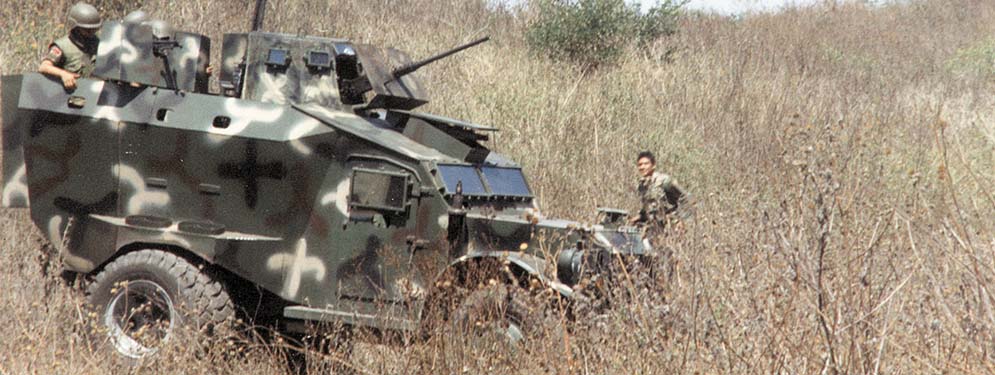By Julio Montes
During World War II, the British Long Range Desert Group (LRDG) gained experience in performing daring raids behind enemy lines using Canadian Chevrolet WA trucks. As soon as the American Jeeps arrived to the hands of the British Special Air Service (SAS) in North Africa, they were adopted for the same daring tasks entrusted to the LRDG trucks. The Jeeps were ideal as weapons carriers, or “gunjeeps.” The Jeep went to inspire post-war generations of 4×4 light utility vehicles around the world, and the modern high mobility multipurpose vehicles. The LRDG Jeeps in particular evolved into today’s light strike vehicles.
The gunjeeps used by Central American armies are tasked with missions typical of armored vehicles: reconnaissance, including advance to contact, battle reporting, rapid forward reconnaissance and observation and surveillance. The combination of firepower, size and mobility allows troops to perform independent raids and deep penetration tasks. Military security outfits use them for escorting unprotected columns, and base perimeter response. The infantry has used them to exploit a gap in the advance, and for internal security. Gunjeeps can also be used for counter-insurgency tasks, to include: armored close support of infantry and fire support. Additional tasks include mobile patrols, anti-arms smuggling patrols, roadblock, escort for convoys and V.I.P.s, peace keeping duties, liaison and communications tasks. The gunjeeps are considered force multipliers and can be used to perform delaying actions in withdrawal, or for operations as flank guards and for anti-airborne and anti-heliborne tasks.
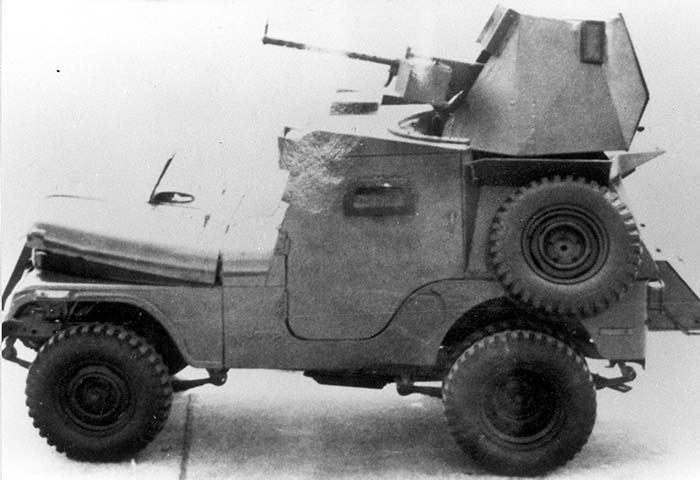
THE M151 MUTT
Due to this versatile employment, it is not surprising that the Central Americans use gunjeeps in considerable quantities. Armed light utility vehicles are pressed to provide convoy and perimeter security, in addition to the main task of liaison. In large armies with strong armored formations, the duties of perimeter response, antitank, reconnaissance, and liaison duties are entrusted to light armored vehicles. In Central America, this role falls on anti-tank and recce armed utility vehicles instead. Their use also include delaying action in withdrawal, acting as flank guards and for anti-airborne and/or anti-heliborne operations.
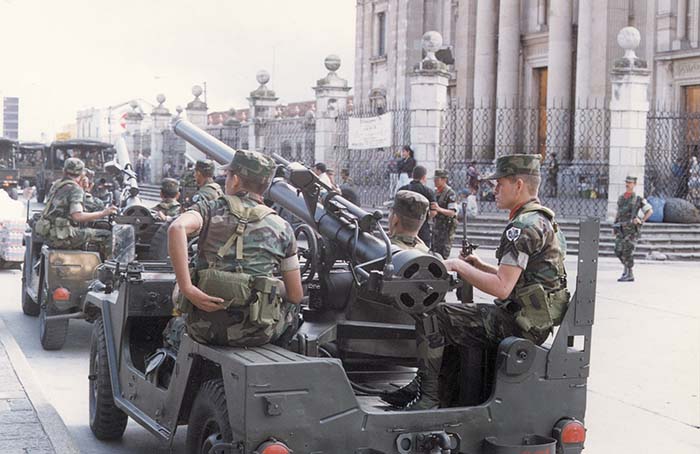
The first Central American CJ-3 gunjeeps, which arrived soon after WWII, were equipped with a single machine gun pedestal in the bed. Some were equipped with either a heavy 12.7mm M2HB machine gun, or a lighter .30” M1919. In Salvadoran and Honduran service, one of the most common matches consisted of single or double mounts of the Madsen Model 1950. The CJ-3 served until replaced by either the M38, the CJ-8 or the M151.
The US delivered considerable quantities of M151s in all its variants to Honduras and El Salvador starting in the mid-1970s; however, few remain in service due to the lack of spare parts. In the weapon carrier configuration (better known as gunjeep), the M151 utility vehicles are used for roadblocks, retaining the capacity to respond with high mobility and firepower. They are used for route and area reconnaissance, mobile patrolling, and security on the move convoys. They are also useful for immediate tactical response.
In 1998, Salvadorian Colonel1 Gustavo Perdomo Hernandez found five M151A2 abandoned at the Special Forces Command base. Perdomo and his mechanics worked overtime to recover all five vehicles. By doing so, Perdomo proved the feasibility and necessity to establish a line to recover this type of equipment.
The rebuilt Salvadorian M151A2s were baptized “Centaurs”. The Salvadorian Special Forces now operate these rebuilt vehicles. They have had their beds extended to accommodate additional radio equipment. One variant is used as command post. There is another variant configured to FAV standards with a M2HB and a M249 SAW; and a third variant sports an M60MG and an M249 SAW. One more variant has been equipped with a 60mm mortar and ammunition boxes. A fifth variant has been equipped with a GE 7.62 mm Mini-gun.
The Nicaraguan National Guard pressed Spanish made CJ-3 and M151 gunjeeps into service during the first revolutionary war of 1977-1979. These sported either a MAG-58 or an M1919 machine gun in the bed. They proved extremely vulnerable during ambushes by the guerrillas, and most were destroyed during the war.
Guatemala was the first Central American recipient of the new M151A1 in the late 1960s, and continuing with M151A2 models after 1970. Guatemala continues to be the largest user of the US-made M151 Jeep in the region. The Chapin2 Army does not use any other type of light utility vehicle, and has avoided purchasing the more common M38/CJ type, or clones. So pleased is the Army with the little utility tactical vehicle, that has even established a “production” line to rebuild them. The Guatemalan Material War Service has rebuilt and delivered fifty of 70 rebuilt M151s to the newly established National Civilian Police in 1999. There are 200 bare chassis waiting for the budget to go through the process, and the Army would like to purchase some additional 300 chassis.
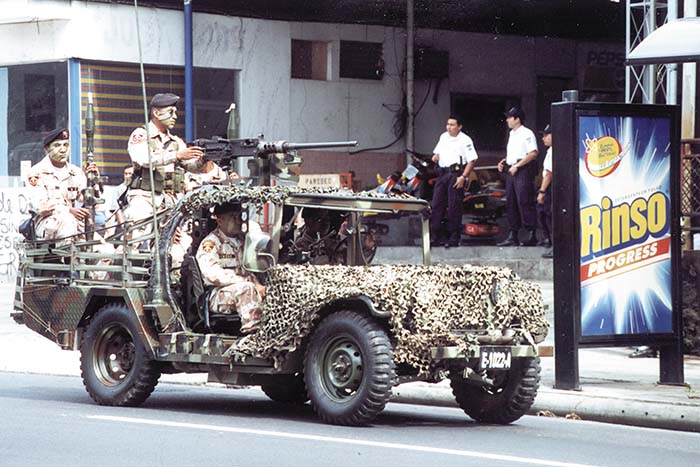
When this author visited the production line, there were some 20 M151 in various stages of recovery, and two models were ready for “redelivery.” The vehicles are stripped down to the bare chassis, and then put back together using new, remanufactured, or overhauled parts.
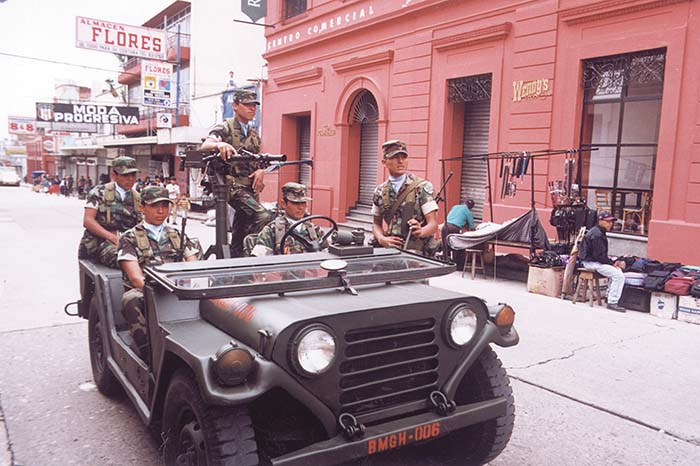
The most powerful M151 gunjeep type deployed in Central America is the M825 variant (M151 jeeps equipped with M40A1 RCL) for antitank and support roles. The M40A1 RCLs in use in Central America come from the US, Israel or Spain.

THE M38A1 AND ITS MANY CLONES
The other widely used “Jeep” in the region is the M38 light utility vehicle. American Motors Corporation (AMC) produced the M38 and M38A1 soon after WWII. The M38 was adopted by the US Army in the 1950s, and was widely distributed to Central American armies. There were also “civilian” variants-the CJ5 and CJ7-that entered service with the various regional armies. The M38 was, in fact, a larger Jeep Willys.
The CJ-5 sported an AMC 4-121 4-cylinder petrol engine, developing 80bhp. The CJ-7 came with a 2.5 liter 4-cylinder petrol engine and the usual manual 4F1R transmission, but there were some models that mounted a more powerful 4.2 liter 6-cylinder engine. By far the most popular version deployed by the Honduran and Salvadoran armies was the CJ-8 Jeep, equipped with a 6-cylinder diesel engine (4.2 Ltr). The Salvadoran models are said to have come from commercial sources, through mediation by an American Colonel, and paid by US aid funds.
There have been numbers of CJ8 Jeep clones that have been delivered to the Hondurans, Salvadoran and Nicaraguan armies.
Honduras received the Ford U-50, a variant of the CJ-5 built by the Brazilian Ford. These models sported a 4-cylinder OHC petrol engine, developing 91bhp, matched to a 4F1R transmission. In Honduran service, the Brazilian made U-50 were supplemented with Brazilian-made Toyota LAND CRUISERS. These mounted a 6-cylinder petrol engine, developing 145bhp.
In the 1980s, Nicaragua received numbers of UAZ-469 4×4 light vehicles. The UAZ-469 vehicles mount the ZMZ 451M 2.445 liter 4-cylinder petrol engine, developing 75hp. However, these Soviet utility vehicles are nothing like the CJ Jeep series. Therefore, the Nicaraguan Popular Army (EPS) acquired several KOREANDO Jeeps in 1990. The KOREANDO built by South Korea resembles the CJ-8, and it is the civilian version of the KEOHWA M-5 & M7 series, equipped with an AMC 6-cylinder petrol engine developing 114bhp. The KOREANDO did not prove to be satisfactory in service, so the Nissan PATROL-made in Spain-were purchased starting in 1996. These Spanish made Nissans are equipped with a P-40 6-cylinder, developing 130bhp.
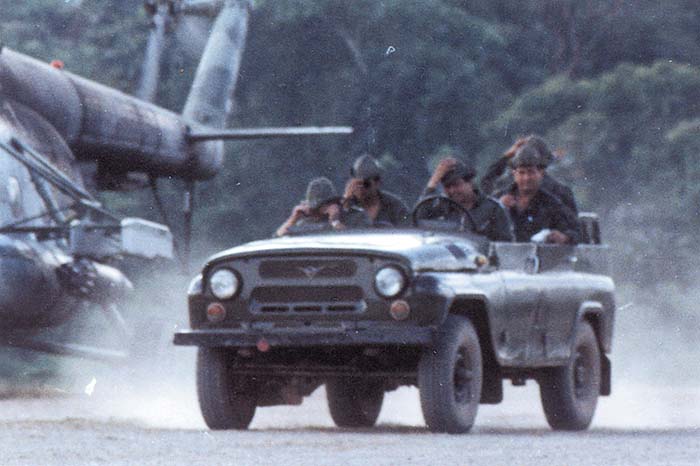
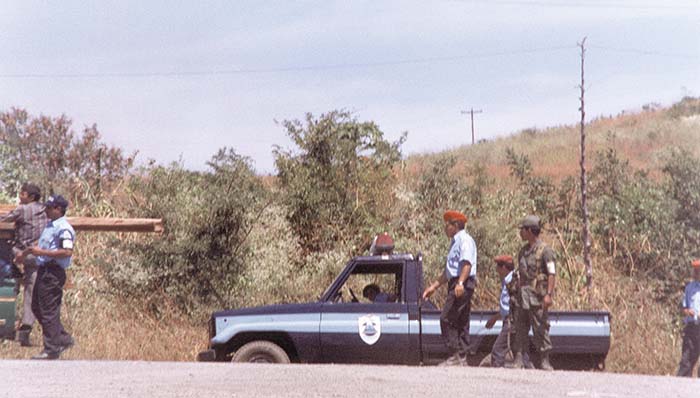
In El Salvador, the M151 gunjeeps were usually equipped with either a 7.62mm Madsen SAETTER or an M1919 machine gun on a pedestal in the bed. The CJ-8 gunjeeps sported either an M1919 or an M60D. These gunjeeps were used for security convoy and rapid response, and therefore, received serious losses in battle. By 1985, the Maestranza (Armed Forces National Workshop) had developed an armored CJ-8 Jeep variant. This carried armored plates around the cab and bed, and a turret equipped with an M2HB machine gun. The suspension was reinforced, and double tires were placed in the rear. The experiment failed since the CJ-8 engine, the AMC 4.2 liter 6 cylinder diesel engine, developing 115hp, overheated due to the excessive weight. The armored CJ-8 project was abandoned and the prototype was relegated to base security at the Military Detachment 1, Chalatenango, where it survived the war, and it was dismantled in 1992.
Very few “civilian” Jeep Wranglers have been deployed in Central America. Nevertheless, the “look and power” of the Wrangler pickup appear to be preferred by the military. The American YJ-L Wrangler pickups are fitted with a Cummins B3.9 diesel engine, developing 105hp, matched to a Chrysler A727 3-speed automatic transmission and New Process M231 2-speed transfer box. The similar (less powerful) CJ8 long bed was a favorite of the Salvadorans, since it was common to use the Jeeps as transport, cramming as many as five soldiers in the bed, plus two crewmen.
All the M40A1s in Salvadoran service were fitted to the long bed (LB) variants of the M38/CJ8 during the civil-war of 1979-1992. These vehicles were deployed as close support, a role proper for an armored vehicle. Therefore, many CJ-8 LB/M40A1 vehicles were equipped with a front armored shield. The Infantry also used their M38 LB/M40A1 in a similar fashion to self-propelled artillery, firing salvoes at the guerrillas and then changing positions before firing again.
The matching of the M40A1 to a long bed jeep has continued with the latest CJ Jeep clones acquired by the Salvadorans. In 1990, the Salvadoran Army took delivery of 36 M240 Storm antitank vehicles (with the M40A1 RCL) and two M-240 reconnaissance and command variants. The M240 MMV series (Multi Mission Vehicles) were designed by Automotive Industries Limited of Nazareth Illit (Israel). The M240s are produced in two frame lengths. The Salvadorans chose the long bed variant (4.5 m) (the other length option is 4.15 m). The M240 is an Israeli near copy of the US-made CJ-8. As designed, the M242 series are equipped with the same CJ-8 engine, a DANA 300 2-speed transfer box and a TREMEC T-176 4F1R transmission. The Salvadorans opted for the more powerful M240 AMC 4L V-6 diesel engine, developing 180 hp, and matched to an AISIN AX-15 5F1R transmission and a NP231 2-speed transfer box. A couple of variants were delivered: Armed (Reconnaissance & antitank/support) and utility (control & communications).
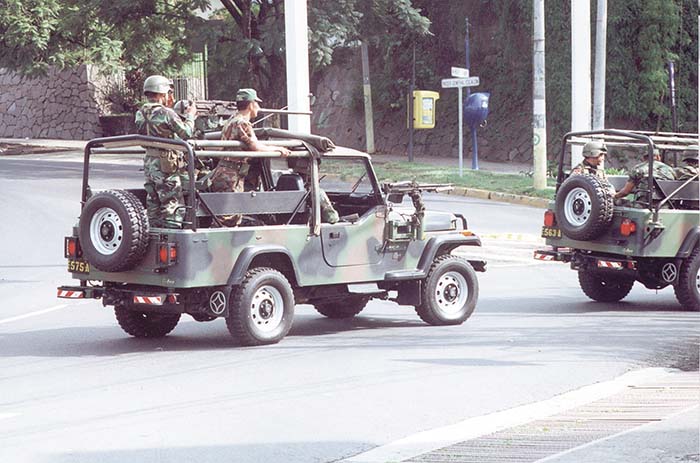
The Reconnaissance variant is the typical armed variant, with an adjustable pedestal in the bed for either a heavy machine gun (12.7mm M2HB) or an automatic grenade launcher. The front passenger door mounts a second 7.62mm machine gun (a M60D in Salvadorian service). The antitank/support variant carries the M40A1 RCL. Surprisingly, the AT/Support variant lacks the light machine gun for the use of the front mounted passenger3.
THE HUMMER
The Honduran Army has taken delivery of several M998 HUMMER transports to operate as light pickup trucks for the three Infantry Brigades and to operate alongside the Saladins of the 1st Armored Cavalry Regiment (RECABLIN). These are the most modern light utility vehicles deployed by any Central American army or police force. The high mobility performance and payload capacity makes the HUMMERs particularly powerful weapon platforms. Therefore, all the Honduran M998s have been equipped with a central mount for a single 12.7mm M2HB in the bed. A second 7.62mm MAG-58 machine gun can be mounted at the front passenger side.

The Honduran HUMMERs have also replaced the M825 utility cars (M151A2 jeeps with 106mm RCL). The HUMMER is ideally suited as a platform of the powerful M40A1, able to carry comfortably a crew of four, in addition to some five times the ammunition carried by a M825. The Honduran Army also distributed some M1069 Prime Mover variants to the RECABLIN, which tow the four M102 howitzers and four M55A2 systems assigned to the Regiment.
THE RBY & CASHUAT
The American experiments with the “dune buggie” as part of the Fast Attack Vehicle program of the early 1980s, inspired a number of experiments around the world.
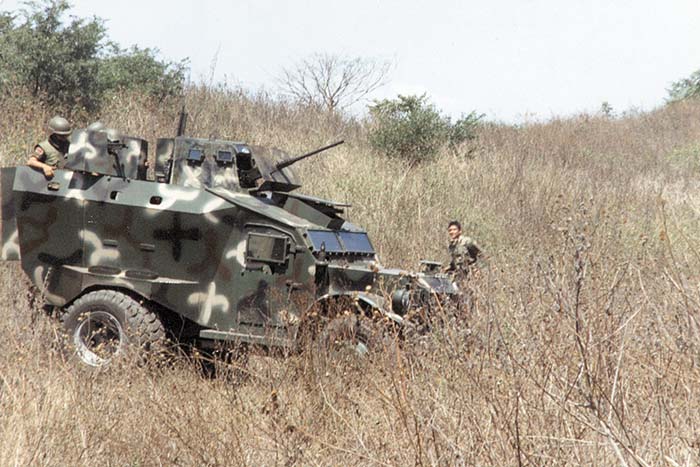
THE RABBI
Perhaps one of the most interesting “gunjeeps” deployed by the Central Americans is the RBY-Mk1 supplied by Israel. The Israelis determined that the idea of the Fast Attack Vehicle (FAV) needed refinement. The FAV concept was sound, providing for speed, mobility and great firepower, but it lacked protection.
The Israelis developed their own version of the FAV. The RBY is not strictly speaking a Jeep or a light utility vehicle. In general, the RBY is based on a concept of the legendary LRDG patrols developed by the SAS during WWII, but providing better speed and improved protection to the crew. The crew can raid the enemy with a large array of light and heavy weapons.
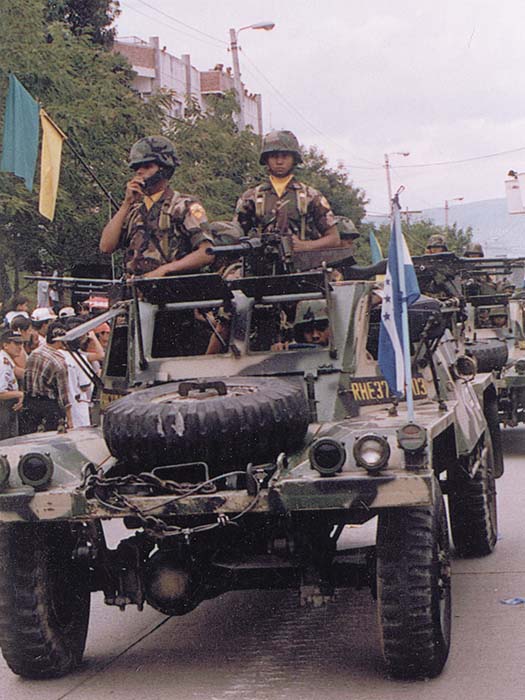
The Honduran Army uses the RBYs in the context developed by the Israelis, much like gunjeeps. The RBYs are organized in a reconnaissance squadron, comprising 4 sections each equipped with two Recce RBYs and 2 Tank Hunter RBYs in addition to four M38 gunjeeps. The RBYs and armed utility M38 vehicles were used in their classical supporting role.
Colonel Emilio David Rodriguez Alvarado, of the Honduran Armored Cavalry Regiment, explained to us that he participated as a young lieutenant in the battle of the Amatillo Bridge in 1984. At the time, Salvadoran FMLN guerrillas overran the local police outpost on the El Salvador side, and prepared to blow up the bridge. The RBYs arrived in time to receive a baptism of fire, pushing back the rebels until Salvadoran troops arrived late the following day to take control of the bridge. One vehicle of this reconnaissance section was sufficient in 1984, to provide enough firepower to beat back the Salvadoran guerrillas who had just wiped out a complete Salvadoran National Police company.
The Honduran 1st Armored Cavalry Regiment (RECABLIN) Commander, Colonel Jorge Andino Andrade, assured that 13 RBYs are operational; however, they denied access to the units’ motor pool to verify this-most likely due to the Salvadoran background of this author. His second in command indicated that Nicaragua is no longer considered a potential enemy, but war with El Salvador is only a matter of time. Ironically, at that particular time, Honduras coast guard units were raiding Nicaraguan fishing boats around Lempira in the North and Fonseca in the South.
The officers also complained of the tight budget to keep the machines running, imposed by the civilian administration. However, with the reluctance of the Armed Forces to open-up to civilian authority, and with some trigger-happy officers still calling for a war with El Salvador, it is only sensible that the civilian authorities retain certain reservations over the military.
The Guatemalan Army considers the RBYs to be light armored vehicles, and they are deployed accordingly. Due to the broken Guatemalan terrain, and the characteristics of the RBYs, they were relegated to operations in the coastal regions and around Jutiapa.
CASHUAT VAL (VEHICULO DE ASALTO LIGERO)
In 1985, the US made available $3 millions to upgrade and re-equip the Salvadoran Cavalry Regiment. Cavalry officers were invited to the 9th Infantry Division, Fort Lewis, Washington, to observe and test the Fast Attack Vehicle being developed by the Special Forces in those days. According to then Cavalry Regiment S3, Captain Miguel Castillo4 the Fast Attack Vehicle was rejected by the Salvadorians because it was too expensive, lacked armored protection and did not provide for a light armored transport variant. The Salvadoran terrain is broken, presenting only a few open areas; therefore, operations of motorized equipment are restricted to paved and dirt roads. The Cavalry Regiment had been tasked with keeping the roads open to transit, so a light armored vehicle for convoy escort and road patrol was needed.
Based on the concept of the Fast Attack Vehicle presented to them in Fort Lewis, the Salvadoran Cavalry Regiment officers requested the Light Assault Vehicle (VAL-Vehículo de Asalto Ligero) from the local National Workshops (Maestranza). The Cavalry provided a Tactical Group and Maestranza a Technical Group to study the production of a locally-made armored pickup truck.
The M37B1 4×4 Dodge pickup chassis was selected to mount a mild steel shell for trials. After all details and problems were resolved, a line was established at the Maestranza HQ, San Salvador. The US Tank Automotive Command supplied 66 kits to ensemble the new armored cars in El Salvador. The Army collected 100 M37B1 chassis from Army barracks nationwide, and more were offered from the Military Assistance Program. The Salvadorian hoped to build 100 armored pickups.
The Army had found that troops riding on the enclosed armored trucks would go to sleep due to the intense heat inside the armored vehicles. Therefore, an open-topped design was selected for the new Light Assault Vehicle to provide some sense of insecurity so troops would keep awake and alert. The Maestranza produced 66 armored pickups denominated Cashuats (“Horse” in Nahuat Amerindian language). They were built in two variants: light armored transport and weapons carrier. As designed-a light armored road patrol vehicle-the Cashuat was a complete success. The VAL program called for a light armored vehicle for roles typically assigned to gunjeeps; in reality, they only supplemented the smaller utility cousins. The M151 and M38 continued to be used by the Cavalry Regiment in reconnaissance sections of 5 gunjeeps. Furthermore, the Salvadorans deployed the Cashuats for counter-insurgency tasks as armored close support of infantry, fire support, and armored troop transports. The Cashuat had not been designed for these roles as they can be considered “light armored long wheelbase gunjeeps.” It lacked the firepower of the Panhard AML-H90 and the mobility of the UR-416. In this supporting role the Cahsuat VAL was considered to be a complete failure.
BLEAK FUTURE
Modernization programs of older vehicles are good investments. The recovery of the M35A2 truck to the A3 standard is one example. The “new” M35A3 consists of an old M35A2 modified with a Cummins 478-ci engine developing 170hp, new 4-speed automatic transmission, 2-speed transfer box, and new axles with super single radial tires. The changes include a new cooling system, split air/hydraulic breaks, new power assisted steering, and central tire inflation system.
Ideally, the M151A2 chassis would go through a similar transformation to a M151A3. This would include an overhauled manual or a new automatic transmission, a Perkins Prima 80T turbocharged 80hp diesel engine (or similar), power steering, improved suspension, wide tires and central tire pressure. As a light strike vehicle, a modernized M151 can be modified Israeli-style, with wire-cutter front post, roll bars, storage boxes, additional radios, a MAG-58 forward over the dashboard for the use passenger side crew, and either an M1919 or MAG-58 in the bed facing rearguard. In fact, the USMC used something similar until 1997. The Guatemalan Army in their M151 “production” line could easily incorporate these suggested modifications.
Guatemala is happy with the M151, and the Hondurans have opted for the HUMMER. The Salvadoran Army is left behind having a number of different light utility vehicles, but without enough of them to make a difference. El Salvador has a requirement for some 300 to 500 modernized M151, and between 300 and 500 modernized M35 trucks in all variants. Salvadoran sources indicate that all US material military assistance has stopped. The only assistance being received is in training. This leaves considerable US-made material relegated to warehouses or the junk yard. The Army lacks even trucks for mobility. The Salvadorans are also to blame since they have been unable to establish a reliable logistic branch and those making military arms and parts purchases appear to be either inept or highly corrupt.
Notes
1 Now General, Special Military Security Brigade Commander.
2 Chapin: Accepted regional nickname, applied to Guatemalans (not a diminutive name).
3 This author considers that the investment on the Storm was unwise. A better investment for the Salvadoran Army would have consisted in acquiring second-hand M113 vehicles, refurbished to A3 standards, or the establishing a recovery line for M151A2s.
4 Today Brigadier General, Salvadorian Army General Inspector.
| This article first appeared in Small Arms Review V4N10 (July 2001) |



